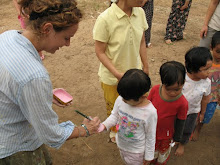Artful Integration: A Collaborative Planning Session kicked off yesterday with a group of educators exploring Arts Integration. First we made collages to introduce ourselves, which helped us go deeper into our personal relationship with the arts, as well as what we hoped to get out of the sessions. Collages were as varied as the individuals that made them.
The artwork ranged from symbolic images and color schemes...
...to a collection of powerful phrases...
...to creative combinations of the two!
Through the collages we were able to deepen our self-expression and foster a creative environment to share ideas and resources.
Next we dove into the question of what makes an authentic arts integration? We looked at some examples to help us answer this question. For instance, the contrast between:
Teaching the ABC's by singing it in a song,
which uses music but the music is merely a vehicle to memorize the academic subject
vs.
Teaching the ABC's letter formation using dance instruction,
which embeds the basic concepts of dance while kids move their bodies into the shape of the letters
From this we considered that two things happen in Authentic Arts Integration:
1. Students learn about both academic topic and art form.
2. Student understanding of academic topic and art form are furthered by the integration.
Since this is not a black and white issue, and there is obviously a spectrum of what "authentic" means to different people, we went got a chance to go deeper into the question. We broke up into groups to investigate more examples of arts integration and discuss their degree of authenticity.
The groups got a set of examples (see below) and were also invited to write their own:
Students explored the events leading up to Indian independence through theatrical re-enactments, as well as studying and writing protest songs from the era, which they presented in a culminating performance for their school community.
Students studied the pre-colonial British era by copying pictures of historical figures from the time period out of their textbook to include in their written reports on the subject.
When studying clouds in Science, students explored the variety of cloud types by painting a series of watercolours that explored various techniques of achieving different cloud formations.
When studying clouds in Science, students made clouds out of white cotton, glued them to cardboard backings, and used them to decorate their classroom.
A teacher used music to teach fractions, by having students clap out the beats to common songs in order to illustrate the concept of ½ and ¼ notes.
When studying clouds in Science, students were instructed to dance around like clouds.
Both groups organized their examples in different ways. One saw some of the examples as strong and fit and ready to go, while others were a little weaker and needed the "prescribed workouts" that they suggested.
The other group organized theirs in a Venn Diagram, showing the subtle variations of "authenticity." This group also worked to come up with a definition of Authentic Arts Integration, which included the observations that "art facilitates learning" and that it should be "child-driven."
This work will be a wonderful foundation for next week's conversation about the benefits and challenges of arts integration. Educators have the homework of seeking out some resources to share about next week's topic: Integrating Art and Math!
Some fantastic and free resources for lesson plans and more information about Arts Integration can be found below:
Arts Edge: Easy search engine to find some super user-friendly lessons for all ages, great but topics are a bit American-centric. Check out both the "Lessons" and the "How-to's"
Arts Everyday: If you click on the "Educators" heading you can find some good sample lessons under the "Programs Directory" tab and a great overview for building a culture of arts integration at your school under the "How to do Arts Integration" tab.
Arts 4 Learning: Helps you search for lesson plans of arts integration with some helpful videos. You need a membership but it's free to sign up.
Learner.org: Download this PDF to go over Art Integration basics and check out the inventory you can use to evaluate your use of art integration in the classroom
Also, we discussed Ellen Winner's work on Studio Habits of Mind, which argues that while Arts Education isn't proven to raise test scores, it is very valuable for developing eight important thinking abilities.
This article by here, Art for our Sake, outlines her ideas nicely.








No comments:
Post a Comment